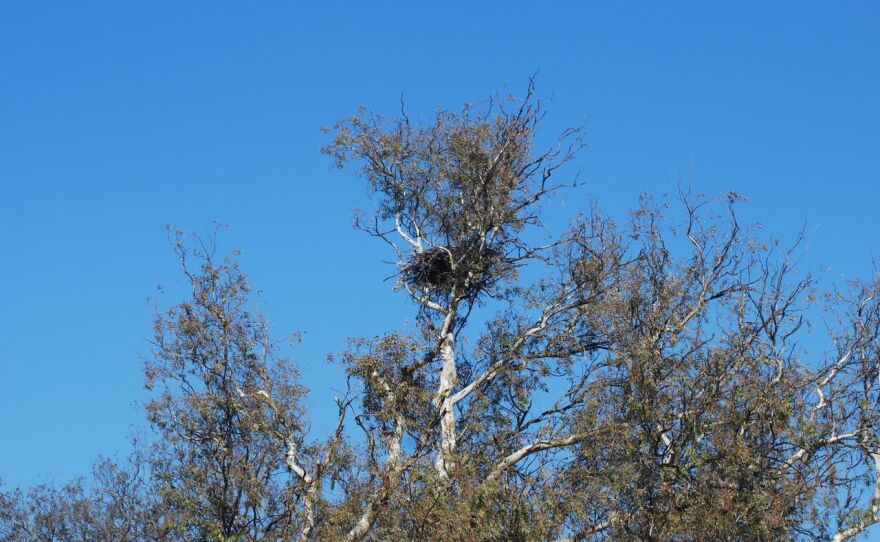Wind whips across a Ramona valley floor on a recent chilly winter afternoon. One end of the valley is apparently a perfect location for a pair of bald eagles to build a tree top nest.
"Here in the Ramona Grasslands, we're only about a mile and a half or so west of the community of Ramona," said Nature Conservancy ecologist Zachary Pincipe.
This 4,500-acre preserve snuggles right up against civilization. That's about 35 miles northeast of downtown San Diego.
The land is mostly flat. Grass dominates the landscape, with a boulder peaking through here and there. And the encroaching homes are scattered around the edge of the mountain meadow.
Once targeted by developers, this little sliver of nature houses an ecosystem that has long been under siege in Southern California. Less than 1 percent of native grasslands remain in the state. That's why this land was targeted for protection. The eagles are a bonus.
"To have them nesting here was completely unexpected. Nobody anticipated having nesting bald eagles as part of the conservation success here in the Ramona Grasslands," said Principe.

The perch that holds the eagle's nest is on top of a eucalyptus tree. It gives the raptors a clear view of the surrounding valley. And just over the horizon to the south are two ponds. The water attracts ducks, geese and coots, birds that provide a steady food supply. And food will be important for a baby eagle, just as important as the massive treetop nest.
"It takes many months for them to construct the nest. It's about five to six feet in diameter and can be two to three feet deep," said Principe. "And yeah, they just grab big sticks from the surrounding area usually three, four feet long, pretty good size diameter. I mean, these are big birds so they can collect pretty large pieces of wood. And then they just weave them together."
"The bald eagle is a magnificent raptor," said Michael Mace, the curator of birds at the San Diego Safari Park. "It's one of the larger raptors in the world and we've chosen it to be our national symbol."

There are a couple of bald eagles living at the Safari Park. The birds have been injured and are not candidates for a return to the wild.
The Ramona nest is another encouraging sign for a species that was, until recently, on the endangered species list. The eagle was pushed to brink by the pesticide DDT, which made its eggs too brittle.
"As the birds were doing their incubation, they were actually breaking their own eggs. So once the toxin was removed from the environment, the birds recovered," said Mace.
The eagle population dropped to about 500 breeding pairs in the lower 48 states in 1963, according the U.S. Fish and Wildlife Service. Now, there are close to 10,000. California has about 200 breeding pairs, but this is only the second nest in San Diego County over the past 80 years. The other is near Lake Henshaw. Observers call it a good thing to see the species expanding its breeding range, even if it is so close to people.
"They have many options on where they might nest. This pair has just happened to set up in a meadow, where there's a stand of a few trees," said Mace. "And are carrying it out. So the birds themselves are comfortable picking that site. What we have to be careful of as observers is that we don't encroach on a nest site like this and disturb them."

Biologists at Ramona's Wildlife Research Institute will do their part to make sure the nest succeeds. It is practically within view of the institute, where Chris Meador is the assistant director.
"Through the years, we've built up a preserve here of about 4,500 acres working with the nature conservancy and the county of San Diego. We've secured that land, protected it and now we believe the bald eagles, for one have a very stable increasing population and two have a safe place here in the Ramona Grasslands to nest," said Meador.
The institute focuses public attention on the many raptors that live in the valley. Hosting a breeding pair of bald eagles is a jewel they never expected to place in their crown.
"They have this nest and if they feel comfortable in the territory they could produce young. And if they don't, we would hope if it's protected properly they'll come back next year and try again," said Meador.
The pair is clearly mature enough to have chicks. Biologists can tell that because the birds' heads are white. What they don't know is how old they are. A young pair could make this a breeding home for years to come.







